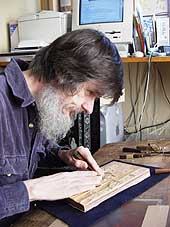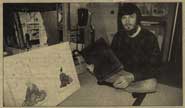13 Another Lucky Number for Surimono Albums
David Bull is as insistent as he is stubborn. No sooner has he sat me down beside his workbench (the only warm room in the house), with younger daughter Fumi (16) creating a Web page on the computer on top of the "kotatsu," than he is demanding how much I know about "hanga" (woodblock prints).
"Hanga were never made to be framed and hung on walls," he states. "Premodern Japan had no such tradition. Prints were objects, not images, to be looked at in natural light. The best way for the art of the craftsman to be appreciated is in your hands, at a window."
 From Jan. 17 to 22 at Tokyo's Gallery Shinjuku Takano (for the 10th time), he will show prints covering the last 13 years. One room will exhibit hanga from his famed "Hyakunin Isshu" series -- reproductions of Katsukawa Shunsho's portraits created to illustrate "waka" poems. The other will show prints from his "Surimono Album" series, including those sold by subscription (just 6,000 yen monthly) during 2001, and taking orders for this year.
From Jan. 17 to 22 at Tokyo's Gallery Shinjuku Takano (for the 10th time), he will show prints covering the last 13 years. One room will exhibit hanga from his famed "Hyakunin Isshu" series -- reproductions of Katsukawa Shunsho's portraits created to illustrate "waka" poems. The other will show prints from his "Surimono Album" series, including those sold by subscription (just 6,000 yen monthly) during 2001, and taking orders for this year.
It's very clever. You receive a beautiful handmade album, into which is slipped a new print that arrives regularly by post, complete with an explanatory essay describing its history and the techniques involved. Since subscribers never know what to expect, the surprise element is strong. At the end of the year, you have 10 prints to share with friends, and mull over for perpetuity.
"People often ask why I spend my life copying the work of others rather than creating my own. But I am not copying. Rather I'm exploring age-old techniques and having a lot of fun at the same time. It's immensely satisfying work. I'm a craftsman, not an artist."
A self-taught carver and printer, David never sells one-off prints, "because they will end up on a wall somewhere, and all my effort go to waste." Though he does sign the hanga he creates for his "albums," he refuses to even initial his New Year's cards. "I want them to be appreciated for what they are, not as some kind of investment."
He shakes his head to think that historic prints are today associated with a single name, like Hokusai. True, Hokusai can be credited with the original concept, but that was all. Every stage was in the hands of a separate craftsman, with the printer adding the colors and surface effects via one block after another with precision.
David saw his first hanga in Toronto. Born in northern England, he was taken to Canada when he was 5. "I was 28 or so, working in a music store, surrounded by Japanese restaurants. Stepping into the Stuart Jackson Gallery, I saw my first 'surimono.' " They were the most stunning things he had ever seen. How on earth were they made?
On the train back to Vancouver, he met a Japanese woman, with whom he subsequently lived and had two girls. He made his first experiment at woodblock printing with an off-cut and a kitchen knife. Then with the first baby (Himi, now 18), visited Japan to show her off to the in-laws, "picking up tools, equipment, paper along the way."
After Fumi came along, Dave dragged the family back to Japan, and because Immigration refused to give him a visa, got hitched the very next day. While teaching English to survive, he was all the time teaching himself to carve and print. "I hadn't yet caught on to the fact that the artist wasn't the craftsman." After a student showed him a book about "Hyakunin Isshu" in the local library, he set about replicating the hanga. He finished his first "Hyakunin" print Jan. 7, 1989.
When he showed the result to his students, the response was overwhelming. "I had no idea 'Hyakunin Isshu' was one of the great pillars of Japanese culture. All the adults said, 'I want one.' " So many wallets were waved that he was quickly printing off his first orders. At which point he drew up a spreadsheet: If he could create 10 prints a year and collect 50 to 100 subscribers, could he make a living. "I was committing myself for the next 10 years, but at 38, it was make or break. I saw it as my chance not to be a failure."
In 1991 his wife returned to Canada to pursue her dream of becoming a doctor, and David quit teaching. 1993 was a tough year. "My first exhibition in Tokyo was a disaster, and my wife and I divorced. It was the halfway show in '94 that took off, thanks to some very welcome publicity."
With the "Hyakunin Isshu" project complete, he began his "Surimono Series" in 1998. This brings to light hitherto unknown hanga from the Edo period through to modern day. "The last print subscribers received was by an artist of my own age now living in Kansas. I don't want to spend my life printing off Japanese 'bijin' (beauties) under cherry blossom."
Dave Bull now operates quite the cottage industry in Ome. He bought the two-story house in which he now lives a year ago, and is transforming it into a five-floor studio home. It's built on the side of a riverbank, and you descend -- for the moment at least! -- through a closet door in the entrance hall. "Very C.S. Lewis, don't you think?"
His daughters -- currently in school in Vancouver, living with their mother -- visit every holiday. On this trip, Fumi has set up a business on the Internet to sell secondhand prints bought for a song in Kanda. "One of the reasons I relate so much family news in our bilingual seasonal newsletter is to show that divorce doesn't have to mean destruction."
David describes himself as just a normal bloke doing something interesting. For Japanese, however, it's eye-opening. His extensive Web page receives as many hits from here as from abroad. You can even watch him at work via a Webcam set up above his bench.
Whereas the Japanese craftsman's world tends to be narrow and deep, he prefers his to be as wide as possible. "The 'Surimono Series' has another two years. Then I shall do something new -- but as always resurrecting forgotten woodblock print masterpieces. Right now I'm interested in 'kuchi-e,' prints originally made for insertion into magazines and never really taken seriously. I always give myself attainable goals."
TV Listings
The 'Woodblock Shimbun' has a full selection of TV programs on file. Videos available include some of David's news appearances, complete feature programs, and some short documentaries on his work. The files are in QuickTime format, and can be easily viewed with your browser.
Program listings are on the Index page ... ![]()
Woodblock Prints in a Different Light
"Let me ask you a silly question: Have you ever seen a woodblock print before?" ukiyo-e printmaker David Bull asked me. "Of course you have. But do you know how to look at a woodblock print?" He held a postcard-sized print under the fluorescent light in his cluttered kitchen. "Is that a woodblock print, or is it printed by a machine, or is it a photograph? (1999)
Full Story. ![]()
David Bull: Woodblock Print Artist
"Japan is such a fascinating country! Individual energy is balanced, so that individuals and society operate in step with each other. I'm not going home to Canada. I'm grateful if I can carve woodbIocks, and I'm delighted to see my skills improve - nothing gives me greater pleasure!" The enthusiasm shown by David Bull (47), an English-born Canadian, is enough to make any Japanese happy. (1999)
Full Story. ![]()
Japanese Art with a Canadian Touch
A British-born artist from Canada is holding an exhibition of his 60 works of ukiyoe woodblock prints, part of his 10-year project to carve and print the Hyakunin Isshu poem collection. (1998)
Full Story. ![]()


